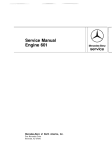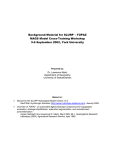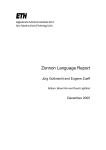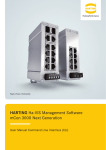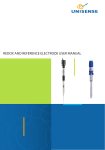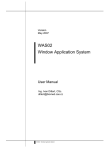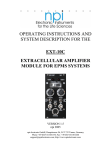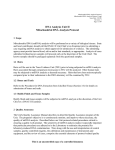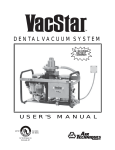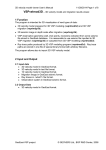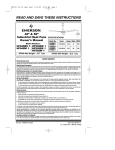Download BSC-BU Base Unit - Warner Instruments
Transcript
Table of Contents 1 PAGE Warranty and Repair Information ........................2 Introduction ............................................................3 BSC-BU Base Unit ............................................4–5 BSC-ZT Chamber Zbicz Top ..............................6–7 BSC-HT Chamber Haas Top ............................8–10 BSC-PC Prechamber ............................................11 Cleaning Instructions............................................12 FIGURES PAGE 1. The BSC-BU Base Unit ......................................4 2. The TC-202A Temperature Controller ..............5 3. The BSC-ZT Chamber Zbicz Top ......................7 4. The BSC-HT Chamber Haas Top ......................8 5. The Brain Slice Chamber System ....................9 6. Placement of the Thermistor Probe ..............10 7. The BSC-PC Prechamber ................................11 Harvard Apparatus Brain Slice Chamber System User's Manual SUBJECT Warranty and Repair Information Harvard Apparatus Brain Slice Chamber System User's Manual 2 Serial Numbers All inquires concerning our product should refer to the serial number of the unit(s). Warranty Harvard Apparatus warranties the instrument(s) for a period of one year from date of purchase. At its option, Harvard Apparatus will repair or replace the unit(s) if it is found to be defective as to workmanship or material. This warranty does not extend to damage resulting from misuse, neglect or abuse, normal wear and tear, or accident. This warranty extends only to the original customer purchaser. IN NO EVENT SHALL HARVARD APPARATUS BE LIABLE FOR INCIDENTAL OR CONSEQUENTIAL DAMAGES. Some states do not allow exclusion or limitation of incidental or consequential damages so the above limitation or exclusion may not apply to you. THERE ARE NO IMPLIED WARRANTIES OF MERCHANTABILITY, OR FITNESS FOR A PARTICULAR USE, OR OF ANY OTHER NATURE. Some states do not allow this limitation on an implied warranty, so the above limitation may not apply to you. If a defect arises within the one-year warranty period, promptly contact Harvard Apparatus, Inc. 84 October Hill Road, Holliston, Massachusetts 01746-1371 using our U.S. only toll free number 1-800-272-2775 or dial (508) 893-8999. Goods will not be accepted for return unless an RMA (returned materials authorization) number has been issued by our customer service department.The customer is responsible for shipping charges. Please allow a reasonable period of time for completion of repairs, replacement and return. If the unit is replaced, the replacement unit is covered only for the remainder of the original warranty period dating from the purchase of the original device. This warranty gives you specific rights, and you may also have other rights which vary from state to state. Repair Facilities and Parts Harvard Apparatus stocks replacement and repair parts. When ordering, please describe parts as completely as possible, preferably using our part numbers. If practical, enclose a sample or drawing.We offer a complete reconditioning service. CAUTION: Not for clinical use on human patients. Introduction 3 The Harvard Apparatus, Inc. brain slice chamber systems offer the investigator two methods of maintaining thin slice of brain tissue in vitro. When used in conjunction with a common base unit (BSC-BU), either the BSC-HT (Haas Top) or the BSC-ZT (Zbicz Top) will maintain brain slice preparations for many hours and allow for stable intracellular or extracellular recording. The BSC-ZT is a full submersion chamber in which solutions flow transversely to the cut surfaces of the slice. The BSC-HT is an interfacetype chamber in which one cut surface of the slice is exposed to a humidified gas mixture. The rapid exchange of inflowing solutions with each top unit allows for rapid adminstration of drugs and changes in the extracellular ionic environment. Harvard Apparatus Brain Slice Chamber System User's Manual Congratulations! You have purchased one of the finest Brain Slice Chambers available to aid you in your research. You will find the Harvard Apparatus, Inc. unit easy to use and easy to maintain. BSC-BU Base Unit Harvard Apparatus Brain Slice Chamber System User's Manual 4 1f Perfusion Output Line 1e Perfusion Output Line 1d Left Elbow 1c Right Elbow 1a 1b Banana Connectors Center Elbow Figure 1. The BSC-BU Base Unit The BSC-BU Base Unit The BSC-BU Base Unit (Figure 1) is adaptable to both the BSC-HT (Haas Top) and the BSC-ZT (Zbicz Top). The base unit consists of a double walled cylinder enclosing a nichrome wire heating element as well as the tubing which carries the superfusing solution to the top unit. Step BU-1 When using the BSC-HT the cylinder must be filled with distilled water. When using the BCS-ZT either distilled water or mineral oil may be used. If there is a chance that both the BSC-ZT and BSC-HT will be used, distilled water should be placed in the cylinder as it would be necessary to clean the mineral oil from the gas dispenser tubes before the BSC-HT could be used. Step BU-2 There are three right angle elbow fittings located on the bottom of the base unit’s double walled cylinder. The center elbow (Fig. 1b) is used to bubble a 95% O2/5% CO2 mixture through distilled water during operation with the BSC-HT; it is not used with the BSC-ZT. The right and left hand elbows are each intended to be connected to the drug(s) being studied. The drug applied to the right hand elbow (Fig. 1c) will flow out of the right hand tube at the top of the cylinder and along the right hand chambers of the Haas Top; the drug applied to the left elbow (Fig. 1d) flows from the left tube at the top of the cylinder and along the left hand chamber of the Haas Top. When using the BSC-ZT, only the right elbow is used; care should be taken to plug the center elbow so that fluid within the BSC-BU does not leak out. BSC-BU Base Unit 5 Step BU-3 The nichrome wire is connected to two banana connectors on the side of the base unit (Fig. 1a). The base unit may also be connected to a Temperature Controller such as the Harvard Apparatus, Inc. Model # TC-202A (Figure 2) which is designed to maintain the perfusate temperature within ±0.2oC.The resistance of the nichrome wire is approximately 2 ohms should the researcher choose another method of applying current. The power source should be capable of delivering approximately 2.5 amps. Since the TC-202A is a Bi-polar/Mono-polar Temperature controller, and the Base Unit uses a resistive heating element, the temperature controller must be set to its Monopolar function.The mono-polar function can be achieved by setting the switch in the back of the TC-202A.The electrical connection from the Base Unit to the Temperature Controller is made by an I/O cable which has a 6 pin din connector at one end and 2 banana plugs (Red and Black) plus a Ring Tongue (for Chassis Ground) at the other end A way to minimize 60Hz noise is by referencing your recording or measuring equipment to the shield of the BNC in the front panel of the TC-202A. Harvard Apparatus Brain Slice Chamber System User's Manual Figure 2. TC-202A Temperature Controller BSC-ZT Zbicz Top Harvard Apparatus Brain Slice Chamber System User's Manual 6 3c 3b 3a Figure 3. The BSC-ZT Zbicz Top The BSC-ZT (Figure 3) is a submersion type chamber in which brain slices are supported on a stiff nylon mesh to allow the perfusing solution to flow transversely across both cut surfaces. Step ZT-1 To assemble the slice chamber using the BSC-ZT, position the top unit so that one of the clear plastic tubes protruding through the top of the base unit (Fig. 1e or 1f) can be connected to the fitting on the bottom of the BSC-ZT (Fig. 3a) and the top can be centered on the BSC-BU. After this connection has been made, place the top unit onto the base unit. Although the top unit is machined to fit into the round opening at the top of the base unit, it is recommended that dental wax or some easily removed adhesive (e.g. rubber cement) be used to secure the top unit. In addition two screw holes and two screws have been provided to secure the BSC-ZT to the base unit. BSC-ZT Zbicz Top 7 An opening has been drilled through the side of the top unit (Fig. 3b) for placement of a thermistor probe (BSC-T2) near the outflow hole at the end of the trough. The thermistor probe is inserted through the luer fitting at the side of the top unit and positioned so the thermistor is in the middle of the trough. Slices in the BSC-ZT can be held on the mesh by a number of methods. As the perfusing solution flows transversely there is little tendency for slices to move vertically. Therefore, slices can be held at a few points that allow for stable recording with microelectrodes. Slices can be held to the mesh with stimulating electrodes, the plastic insert (Fig. 3c) or other wire holders. The number of points at which a slice is immobilized depends on the size of the tissue. For example, guinea pig hippocampus (approximately 3 x 6 mm) is stable when held at 4 points while smaller slices may require only 2 or 3 points. Slices can also be held by covering them with a piece of fine nylon net which can be purchased at a fabric store. A wide mouthed pipette, made by cutting the tapered end off a Pasteur pipette, can be used to transfer slices to the chamber. This procedure should be done with the solution flow stopped. When transferring slices a fine bristled brush should be positioned between the mouth of the pipette and the end of the mesh nearer to the outflow dam. The brush can then be used to position the slice. Immediately before starting the solution flowing, place a few drops of the perfusing solution on the slice so that the chamber is filled. This will prevent surface tension from lifting the slice, a result when the chamber fills from the side. A flow rate of 1 ml/min may suffice at room temperature while warmer temperatures will require higher flow rates. To insure even flow through the chamber, a nylon mesh (similar to the mesh supporting the slice) can be positioned between the inflow port and the support mesh. A newly cleaned chamber may "slurp", that is, fluid will alternately build up then flow over the dam. If this occurs, place a piece of tissue paper or cotton thread at one edge of the dam to act as a wick Step ZT-3 The investigator is to supply the necessary electrical ground. The ground device (agar bridge or Ag/AgCl wire) should be positioned between the end of the mesh and the outflow dam to prevent disruption of fluid flow over the slice. Be aware that the position of the ground may effect the fluid level near the dam and thus the fluid level of the chamber. Harvard Apparatus Brain Slice Chamber System User's Manual Step ZT-2 BSC-HT Haas Top Harvard Apparatus Brain Slice Chamber System User's Manual 8 4a 4f 4b 4c 4d 4e Figure 4. The BSC-HT Haas Top The BSC-HT (Figure 4) is an interface-type chamber which provides rapid fluid exchange and stability for intracellular recordings. Slices rest on elastic nylon mesh around which a thin sheet of physiological saline flows by capillary action. Slices are oxygenated by a warmed and humidified mixture of 95%O2,/5%CO2, which flows across the top surface of the slice. (A flow rate of 0.5 ml/min. is recommended). Step HT-1 To assemble the BSC-HT, position the top unit so the two clear plastic tubes protruding through the top of the base unit (Fig. 1c and 1d) can be connected to the two fittings on the bottom of the BSC-HT (Fig. 4a). After these connections have been made, place the top unit onto the base unit. Although the top unit is machined to fit into the round opening at the top of the base unit, it is recommended that dental wax in addition to the two nylon hold-down screws, be used to secure the top unit. BSC-HT Haas Top 9 An opening has been machined through the side of the top unit (Fig. 4b) for placement of a thermistor probe near the inflow port. The thermistor probe is inserted through the luer fitting. It should be fully inserted so that the thermistor tip is positioned near the center of the groove designed to accommodate it. Slices rest on elastic nylon mesh (pantyFigure 5. hose type) which must be installed The BSC-BU with BSC-HT, BSC-ZT and BSC-PC by the investigator along the bottom surface of the green plastic frames which are supplied (see Figure 6). To mount the nylon mesh,cut a piece of mesh approximately 5 x 11 cm.Gently stretch one end of the mesh under the side of the green plastic frame with the milled out channels and push the frame and mesh into the groove of the BSC-HT. The frame should be above the mesh and positioned on the horizontal portion of the groove. The small circles cut in the frame (Fig. 4d) are the prechambers and should be positioned above the inflow ports (farthest from the lip of the chamber) (Fig. 4e). The remaining mesh should hang over the lip of the top unit. Cut the section of mesh which hangs over the edge to form a point. The solution leaving the chamber will drip from this point. Alternatively, it is possible to use a smaller piece of nylon mesh under the frame and use a second piece of mesh or tissue paper to carry solution over the lip of the chamber. The BSC-HT is designed so that the effects of two drugs can be studied simultaneously-one drug flowing down the left side of the chamber and the second down the right. Intermixing has been found to be negligible. Once assembled, the chamber is connected to the sources of perfusing solution by the luer fittings located at the bottom of the base unit. Flow rates of 0.5 mil/min per chamber can be obtained by keeping the solutions in bottles pressurized to approximately 0.2 kg/CM2 by a 95% O2/5% CO2 gas mixture. Electronically switched valves are recommended for solution changes to minimize disruption of solution flow. Harvard Apparatus Brain Slice Chamber System User's Manual Step HT-2 BSC-HT Haas Top Harvard Apparatus Brain Slice Chamber System User's Manual 10 6d 6e 6a 6f 6a 6c 6b Figure 6. Placement of the Thermistor Probe The bubblier port, the center elbow on the bottom of the chamber base (BSC-BU) (Fig. 1a), is to be connected to a source of 95% O2/5% CO2. The rate of flow should be adjusted so the flow across the slice keeps the top surface moist and oxygenated. A high gas flow rate which is too high may produce bubbles which are too large and the gas will be inadequately moistened, resulting in drying. After the gas is bubbled through the water in the base unit, it enters the top through the port at the inflow end of the top (Fig. 4f) and passes over the slices. The slotted top plate should be adjusted to cover as much of the slice as possible while allowing room to position microelectrodes. Proper positioning of this plate is necessary to prevent the slice from drying. If necessary, holes can be drilled in the slotted cover plate in order to gain better access to the slice. Also, a piece of filter paper should be inserted between the cover plate and the top of the chamber. This is to prevent water droplets from accumulating on the inside of the cover plate and dropping onto the slice. The electrical ground, Ag/AgCl wire (Fig. 4c), is supplied and should be positioned as near the slice as possible, through the insert hole nearest the center of the chamber, downstream of the thermistor port. A wide mouthed pipette, made by cutting a Pasteur pipette, can be used to transfer slices from the holding bath to the chamber. Slices should be positioned in the longer grooves of the green plastic frame. Slices may be transferred to the chamber with solution flowing. The fluid level in the chamber can be adjusted by placing a piece of tissue at the edge of the frame to act as a wick. BSC-PC Prechamber 11 7c 7a Figure 7. The BSC-PC Prechamber The prechamber (Figure 7) is designed to maintain 8-12 slices viable for several (6-8) hours prior to transfer to the brain slice chamber 1. Attach one end of a hose to the gas inlet port on the side of the prechamber (Fig. 7a) and the other end of the hose to a source of 95% O2/5% CO2. Do not start the gas flow yet. 2. Fill the prechamber to within 1/16 inch of the top with physiological saline maintained at room temperature. 3. Using a wide mouth pipette, transfer the cut slices to the prechamber by lowering the pipette into the large opening at the top (Fig. 7b) to the proximity of the nylon mesh and release the slice into the mesh. 4. Turn on the gas (input pressure should not be more than 5 psi). Adjust the flow using the valve provided (Fig. 7c) so that gas flows vigorously but not to the extent that the turbulence causes spillage.The bubbling gas oxygenates the saline and creates a circular fluid flow which continuously enriches the slices. Harvard Apparatus Brain Slice Chamber System User's Manual 7b Cleaning Instructions Harvard Apparatus Brain Slice Chamber System User's Manual 12 Run distilled water through the chamber and perfusion lines after every use. Water should not be allowed to remain in the perfusion lines or chamber as this promotes bacterial growth. Removing the water by a gentle vacuum will decrease the number of times cleaning is needed. The BSC chamber should be periodically cleaned by passing 100-200 ml of 1N HCI through both the base unit and the top unit being used. Immediately after the acid wash, 200 ml or more of distilled water should be run through the system. DO NOT allow the HCI solution to remain in the chamber. DO NOT use the organic solvents, including ethanol, to clean the chamber as these substances can damage components and seals. Other cleaning agents such as Ter-g-A-Zyme made by Alconox can be used. This is a concentrated, anionic detergent with protease enzyme for manual and ultrasonic cleaning. Excellent for removal of proteinaceous soils, tissue, blood, and body fluids from glassware, metals, plastic, ceramic, porcelain, rubber and fiberglass with no interfering residues. Ideal as a cleaning agent in Reverse Osmosis and Ultra-Filtration Systems. USDA authorized. Dilute 1:100. pH 9.5


















